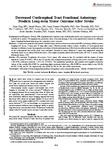Decreased corticospinal tract fractional anisotropy predicts long-term motor outcome after stroke

Non accesible ata 9999-99-99
Use este enlace para citar
http://hdl.handle.net/2183/40831Coleccións
- Investigación (FCS) [1293]
Metadatos
Mostrar o rexistro completo do ítemTítulo
Decreased corticospinal tract fractional anisotropy predicts long-term motor outcome after strokeAutor(es)
Data
2013-05-07Cita bibliográfica
Puig J, Blasco G, Daunis-I-Estadella J, Thomalla G, Castellanos M, Figueras J, Remollo S, van Eendenburg C, Sánchez-González J, Serena J, Pedraza S. Decreased corticospinal tract fractional anisotropy predicts long-term motor outcome after stroke. Stroke. 2013 Jul;44(7):2016-8.
Resumo
[Abstract] Background and purpose: Nearly 50% of patients have residual motor deficits after stroke, and long-term motor outcome is difficult to predict. We assessed the predictive value of axonal damage to the corticospinal tract indexed by diffusion tensor imaging fractional anisotropy for long-term motor outcome.
Methods: Consecutive patients with middle cerebral artery stroke underwent multimodal MRI, including diffusion tensor imaging ≤12 hours, 3 days, and 30 days after onset. Clinical severity, infarct volume, location of corticospinal tract damage on diffusion tensor tractography, and ratios of fractional anisotropy (rFA) between affected and unaffected sides of the corticospinal tract at the pons were evaluated. Severity of motor deficit at 2 years was categorized using the Motricity Index as no deficit (Motricity Index, 100), slight-moderate deficit (Motricity Index, 99-50), or severe deficit (Motricity Index, <50).
Results: We evaluated 70 patients (28 women; 72±12 years). rFA values at day 30 correlated with the degree of motor deficit at 2 years (P<0.001). rFA at day 30 was the only independent predictor of long-term motor outcome (odds ratio, 1.60; 95% confidence interval, 1.26-2.03; P<0.001). The sensitivity, specificity, and positive and negative predictive values of the cutoffs rFA<0.982 for predicting slight-moderate deficit and rFA<0.689 for severe deficit were 94.4%, 84.6%, 73.9%, and 97.1%, respectively, and 100%, 83.3%, 81.3%, and 100%, respectively.
Conclusions: rFA at day 30 is an independent predictor of long-term motor outcome after stroke.
Palabras chave
Cerebral ischemia
Diffusion tensor imaging
Franctional anisotropy
Diffusion tensor imaging
Franctional anisotropy
Descrición
Brief report
Versión do editor
ISSN
0039-2499





